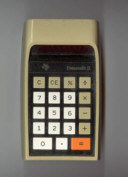
DATAMATH CALCULATOR MUSEUM
 |
DATAMATH CALCULATOR MUSEUM |
Additional Pictures
| The backside
of the Phoenix 1 prototype looks similar to the released
TI-Nspire CAS product, but sports a strange color.
|
The 4 AAA-sized
batteries of the Phoenix 1
prototype are accessible from the backside of the calculator.
|
| We
learned how to read the label of this Texas
Instruments Phoenix 1 protoype: Engineering Validation Test, First Series, Lot B, Serial #118.
|
|
| The internal
construction of the Phoenix 1 makes use of just 3 printed circuit boards
(PCBs), one for the gray-scale LC-Display and power supply, one for the computing unit and the keyboard.
|
|
| The frontside of the
PCBs reveal the construction of the 240 * 320 pixel gray-scale LC-Display, the TI-OMAP and a total of three different memory chips.
|
|
| The brain of the
Phoenix 1 prototype is actually a System-on-Chip based on the OMAP architecture from Texas Instruments. We assume that the tiny housing hosts a 78 MHz ARM9 32-bit RISC processor.
|
|
| The Phoenix uses three
different memory chips, a 256k*16 NOR Flash-ROM, 32M Bytes
NAND Flash-ROM, and 16M*16 SDRAM. The clock frequency of the SoC is 12 MHz.
|
|
| The 320 *
240 pixel gray-scale LC-Display needs a total of three drivers. We located this Novatek NT7702 row-driver and two unidentified column-drivers.
|
|
If you have additions to the above article please email: joerg@datamath.org.
© Joerg Woerner, January 4, 2012. No reprints without written permission.